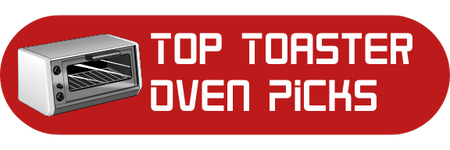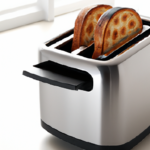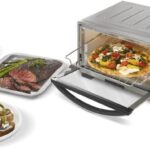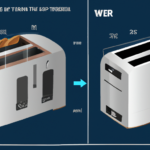
Hey there! Are you wondering if toaster ovens are safe to use with children around? Well, you’ve come to the right place. Let’s dive into this topic and find out!
In this article, we’ll explore the safety measures you can take when using a toaster oven in the presence of children. We’ll discuss tips for preventing accidents and burns, as well as the benefits of teaching your little ones about kitchen safety. So stay tuned, and we’ll make sure you have all the information you need to make the right decisions when it comes to using toaster ovens with your kids around.
1. Potential Hazards of Toaster Ovens
Toaster ovens are a convenient and versatile kitchen appliance, but they can also pose potential hazards, especially when used in the presence of children. It is important to be aware of these hazards to ensure the safety of your little ones.
1.1 Hot Surfaces
One of the main hazards of toaster ovens is the hot surfaces. The exterior of the toaster oven can become extremely hot during and after use, posing a burn risk if touched. Children may accidentally come into contact with the hot surfaces and sustain burns.
To prevent this, make sure to keep children at a safe distance from the toaster oven when it is in use, and teach them not to touch the appliance while it is hot.
1.2 Electric Shock
Another potential hazard is electric shock. Toaster ovens are powered by electricity and have electrical components that, if exposed, can pose a risk of electric shock. Children may be inclined to explore and touch the toaster oven, increasing the risk of accidental contact with these components.
To reduce the risk of electric shock, keep the toaster oven out of reach of children when not in use, and ensure that the appliance is properly maintained and in good working condition.
1.3 Burns and Scalds
Toaster ovens also pose a risk of burns and scalds. When cooking or baking, hot food or liquids may spill or splatter, causing burns if they come into contact with the skin. Children may accidentally touch the hot food or get too close to the hot oven, increasing the risk of burns and scalds.
To prevent burns and scalds, educate your children about the potential dangers of hot food and liquids, and ensure that they understand the importance of keeping a safe distance from the toaster oven when it is in use.
2. Safety Measures to Consider
While toaster ovens do present potential hazards, there are several safety measures you can take to minimize the risk and ensure the safety of your children.
2.1 Keep Children at a Safe Distance
The first and most important safety measure is to keep children at a safe distance from the toaster oven when it is in use. Create a designated “safe zone” where children are not allowed to enter while the toaster oven is hot. This will help prevent accidental burns or contact with hot surfaces.
2.2 Supervision and Education
Supervision and education are key in ensuring the safety of children around toaster ovens. Always supervise your children when they are in the kitchen, especially when the toaster oven is being used. Teach them about the potential hazards and how to safely use kitchen appliances.
2.3 Proper Use of Appliances
Teach your children the proper use of toaster ovens and other kitchen appliances. Make sure they understand how to operate the toaster oven safely and how to handle hot food or liquids. Reinforce the importance of following instructions and using the appliances responsibly.
3. Importance of Childproofing
Childproofing your kitchen is crucial to create a safe environment for your children. Here are some important childproofing measures to consider when using toaster ovens.
3.1 Childproofing the Kitchen
Install safety gates or barriers to keep young children out of the kitchen when you are cooking or using appliances like toaster ovens. Use drawer and cabinet locks to prevent children from accessing hazardous items, such as knives or cleaning products.
3.2 Ensuring Safety Features
When purchasing a toaster oven, look for safety features such as automatic shut-off and cool-touch exteriors. These features can greatly reduce the risk of burn injuries.
3.3 Secure Cord Placement
Ensure that the toaster oven’s power cord is placed securely and out of reach of children. Avoid leaving the cord hanging or within easy reach, as children may be tempted to pull on it and potentially cause the appliance to fall.
4. Understanding Toaster Oven Features
Toaster ovens come with a variety of features that can enhance their safety and functionality. Understanding these features will help you make informed decisions when using toaster ovens with children around.
4.1 Timer Function
Many toaster ovens come with a timer function, which allows you to set a specific cooking time. This can be useful in preventing overcooking or overheating, reducing the risk of burns and fires.
4.2 Automatic Shut-off
Some toaster ovens are equipped with an automatic shut-off feature that turns off the appliance after a certain period of inactivity. This feature can be particularly useful in preventing accidents if you forget to turn off the toaster oven.
4.3 Cool-touch Exterior
A cool-touch exterior is a valuable safety feature to look for in a toaster oven. This means that the exterior surface of the oven remains cool to the touch even when the appliance is in use, significantly reducing the risk of burns from accidental contact.
5. Proper Maintenance and Cleaning
Regular maintenance and cleaning of your toaster oven are essential for both safety and performance. Here are some key points to consider.
5.1 Regular Cleaning
Clean your toaster oven regularly to remove any food debris or grease buildup. Follow the manufacturer’s instructions for proper cleaning procedures. A clean toaster oven will not only function better but also reduce the risk of fire or smoke.
5.2 Checking for Damages
Regularly inspect your toaster oven for any signs of damage, such as frayed cords or loose components. If you notice any issues, discontinue use and have the appliance repaired or replaced.
5.3 Avoiding Repairs
If your toaster oven requires repairs, it is crucial to have it serviced by a qualified technician. Attempting to repair the appliance yourself may result in further damage or potentially dangerous electrical issues.
6. Alternative Cooking Methods
If you have concerns about using a toaster oven with children around, there are alternative cooking methods that you can consider.
6.1 Microwave Ovens
Microwave ovens are a popular and convenient alternative to toaster ovens. They can quickly heat or cook food without the need for preheating. However, it is important to ensure that your children understand the proper use of microwave ovens and the potential hazards associated with them, such as hot food or liquids.
6.2 Convection Ovens
Convection ovens are another alternative to toaster ovens. They use a fan to circulate hot air, resulting in faster and more even cooking. However, convection ovens can also have hot surfaces and potential hazards, so it is important to follow safety measures and supervise children when using them.
6.3 Induction Cooktops
Induction cooktops are a safe alternative for stovetop cooking. They use electromagnetic fields to heat cookware directly, leaving the surface cool to the touch. Induction cooktops eliminate the risk of open flames or hot burner surfaces, making them a safer option when children are around.
7. Ensuring a Safe Kitchen Environment
In addition to following safety measures specifically related to toaster ovens, it is important to create a safe kitchen environment overall.
7.1 Organized and Clutter-free Space
Keep your kitchen organized and clutter-free to eliminate potential hazards. Make sure that countertops and cooking areas are clear of unnecessary objects and properly organized.
7.2 Securely Storing Hazardous Items
Store hazardous items such as knives, cleaning products, or other sharp objects in locked drawers or cabinets. This will prevent children from accessing these dangerous items and minimize the risk of accidents.
7.3 Safe Use of Kitchen Tools
Teach your children proper use and handling of kitchen tools, such as knives or graters. Supervise them when they are using these tools and gradually introduce them to age-appropriate tasks as they develop their cooking skills.
8. Behavioral Guidelines for Children
In addition to safety measures, teaching children proper behavior and responsibility in the kitchen is essential for their overall safety.
8.1 Teaching Kitchen Safety Rules
Establish clear kitchen safety rules and communicate them effectively to your children. Teach them about the dangers of hot surfaces, electrical appliances, and handling hot food or liquids.
8.2 Discouraging Unsafe Behavior
Discourage unsafe behavior such as running in the kitchen, climbing on countertops, or playing with kitchen appliances. Encourage your children to respect the kitchen as a potentially dangerous area and to always ask for permission or assistance when using appliances.
8.3 Practicing Caution Around Appliances
Teach your children to exercise caution and be mindful of their surroundings when using kitchen appliances. Emphasize the importance of not leaving appliances unattended and turning them off properly after use.
9. Introducing Cooking Skills Gradually
As children grow older, gradually introduce them to age-appropriate cooking tasks to develop their skills and confidence in the kitchen.
9.1 Age-appropriate Tasks
Assign age-appropriate tasks to your children, such as washing fruits and vegetables, mixing ingredients, or setting the table. This will help them gain confidence and build a foundation for safe cooking habits.
9.2 Building Confidence
Encourage your children to experiment with simple recipes or assist you in meal preparation. By gradually building their confidence, they will develop a love for cooking while learning important safety practices.
9.3 Encouraging Healthy Eating Habits
Use cooking as an opportunity to educate your children about the importance of healthy eating habits. Teach them about nutrition, portion sizes, and the benefits of balanced meals. This will not only promote their well-being but also enhance their understanding of safe and responsible cooking practices.
10. Conclusion
In conclusion, toaster ovens can be safe to use with children around if proper safety measures are taken. While they do pose potential hazards, such as hot surfaces, electric shock, and burns, these risks can be minimized through supervision, education, childproofing, and understanding the features of the appliance.
It is important to strike a balance between independence and safety when involving children in kitchen activities. By implementing the suggested safety measures, gradually introducing cooking skills, and promoting a safe kitchen environment, you can create a positive and educational experience for your children in the kitchen.
Remember, the key to ensuring the safety of children around toaster ovens is supervision, education, and practicing caution at all times. By following these guidelines, you can confidently enjoy the convenience and versatility of toaster ovens while keeping your children safe.






